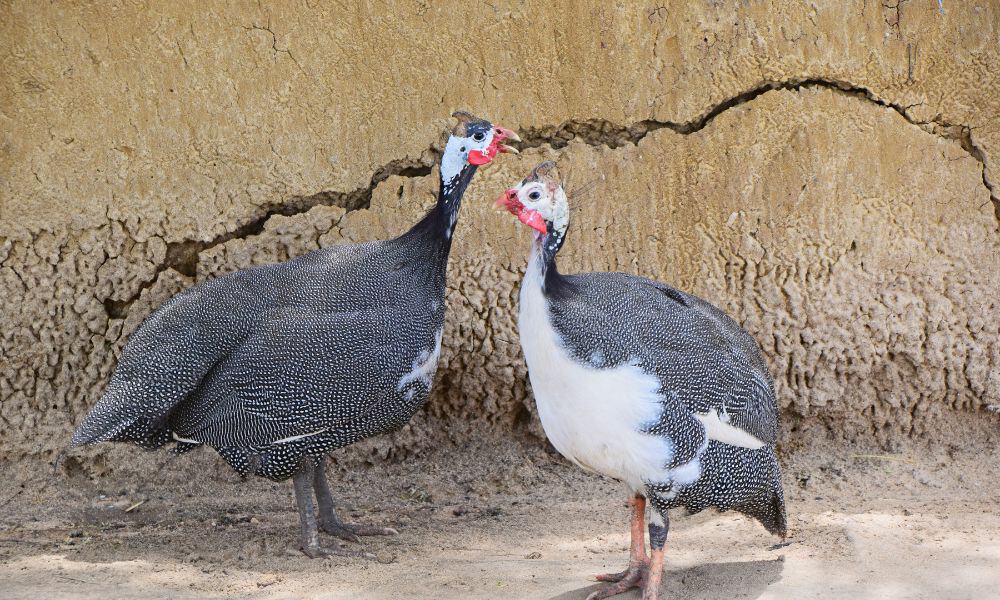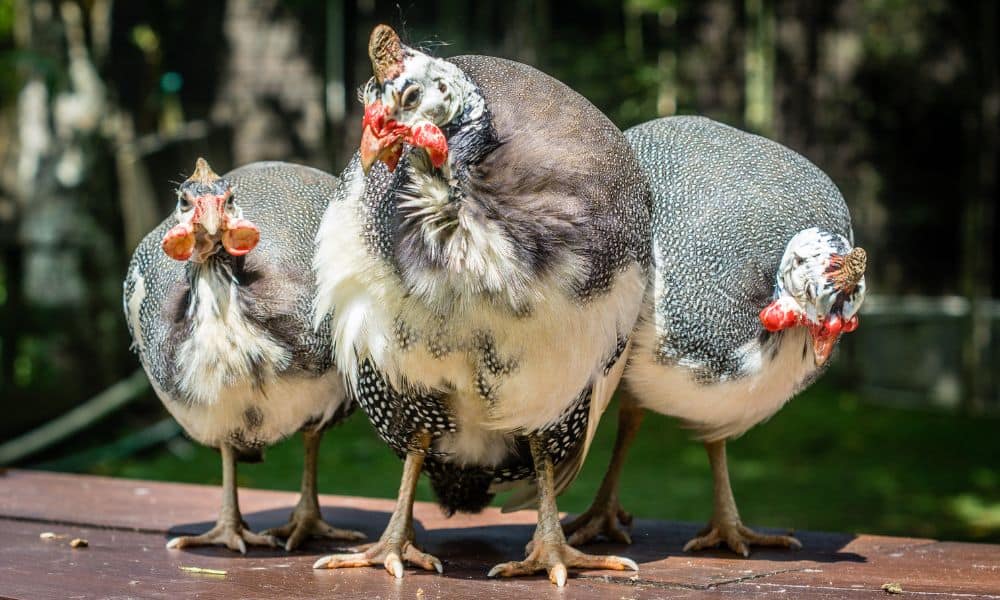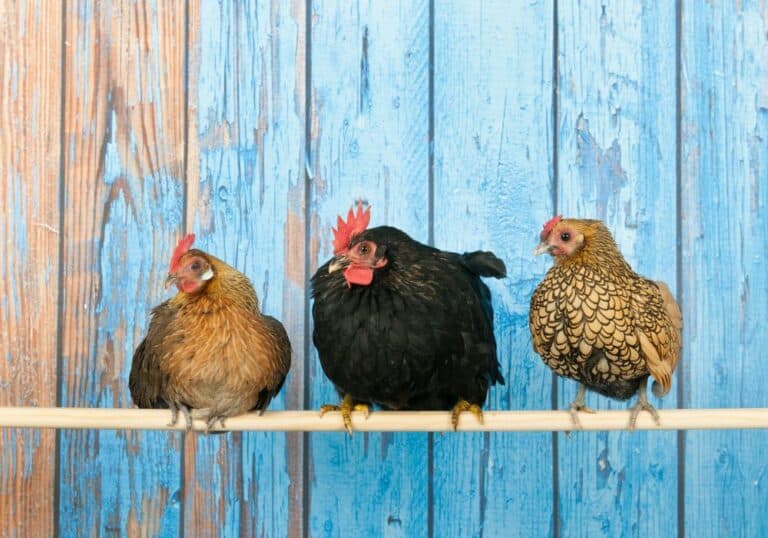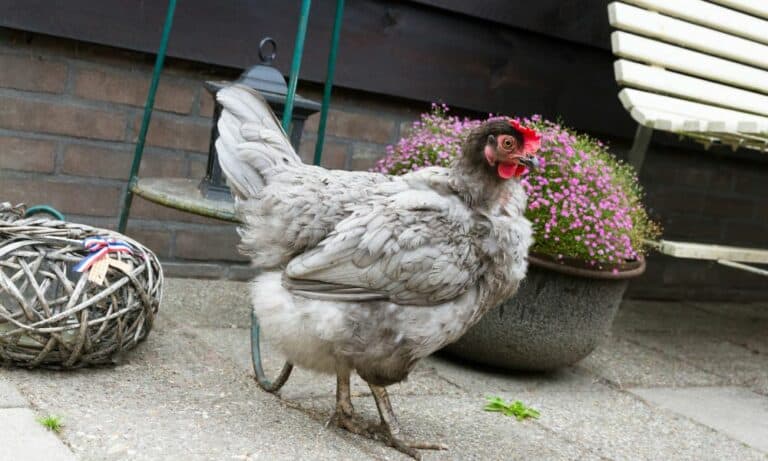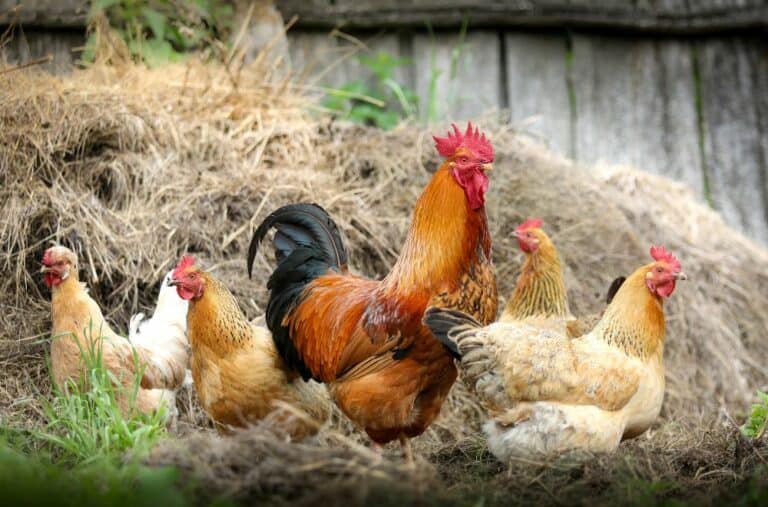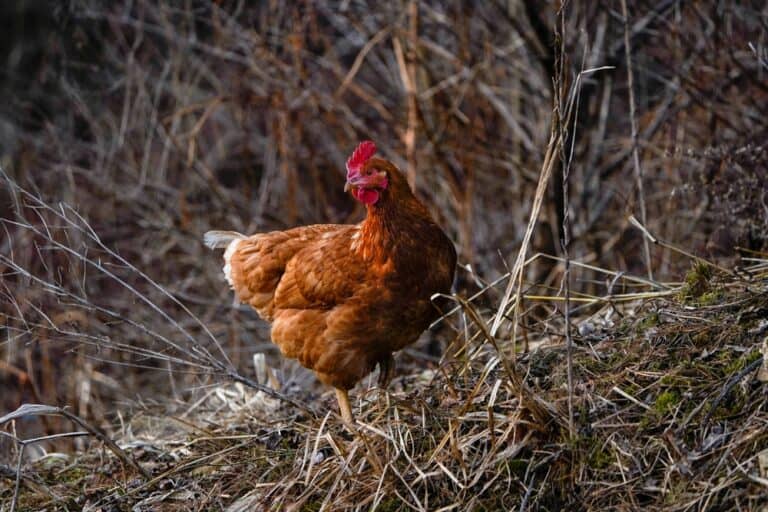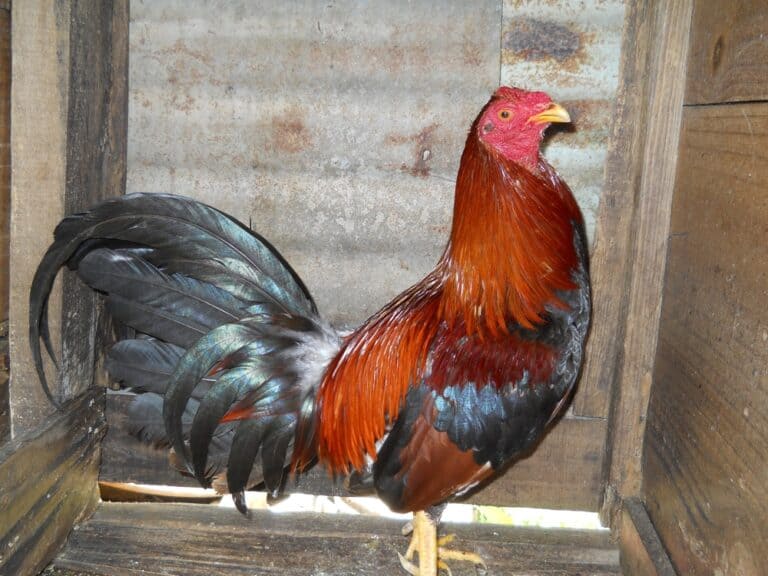You’re probably familiar with ducks, hens, and geese, but what is a guinea fowl? It’s a black-and-white speckled bird with a tiny head that looks a lot like a turkey’s. Guinea fowls are gallinaceous birds, which means they have big meaty bodies and feed off the ground, mostly eating bugs and seeds. They’re ideal for domestication because of their eggs and their size.
The Origin of Guinea Fowls
Guinea fowls were first discovered on the Guinea Coast in West Africa. That’s how they got their name. They’re sometimes referred to as pet speckled hens, pearl hens, or original fowl, and they’re descended from the wild Helmeted Guinea Fowl. The Helmeted Guinea Fowl has the same black feathers with white spots, but it has a turquoise head instead of a white one.
Guinea fowls are comparable to partridges but they have featherless heads, similar to turkeys or vultures. They’re 15” to 28” long and weigh 1.5lb to 3.5lb, with guinea hens being larger than guinea cocks. Tame guinea fowl species have black or grey feathers dotted with dense white spots for that speckled appearance. In the wild, they’re monogamous and mate for life.
That said, when you domesticate these birds, some species – like the Kenyan Crested Guinea Fowl and the Helmeted Guinea Fowl – can adopt the polygamous approach of chickens, with one guinea cock attending to five or six guinea hens. But they’re happiest in mated pairs with one guinea hen for every guinea cock, and they maintain this hierarchy within their flocks.
A few guinea fowl genera like the Agelastes, Guttera, and Acryllium practice polyandry, where one guinea hen has several guinea cocks. But guineas are generally territorial, so they prefer small groups of less than ten fowls when they live in enclosed spaces. They thrive in free-range set-ups where they can nest on the ground and forage for insects and seeds at will.
Guinea Fowl Species
We’ve just mentioned guinea fowl genera, which is the plural of genus. It’s the scientific rank above a species, and we listed the first three. The fourth genus is Numida – the Helmeted Guinea Fowl that was bred and tamed to become the domestic guinea fowl. Below, we’ll look at some species of guinea fowls from all four genera. Notably, only the Numida are spotted.
- Helmeted Guinea Fowl
- Domestic Guinea Fowl
- White-Breasted Guinea Fowl
- Black Guinea Fowl
- Vulturine Guinea Fowl
- Plumed Guinea Fowl
- Crested Guinea Fowl
While most domestic guinea fowls have black or grey with tons of white spots i.e. pearl colored, they can be bred in other colors like lavender, pewter, purple, chocolate, slate, blue, bronze, and blonde. You may also find pied guinea fowls that have large swathes of two or three colors on their breasts and wings. Pied guinea fowls mostly have white or blonde.
Guinea Fowls and Eggs
A domestic guinea fowl might sometimes be called a gleany or a pintade as well as the pearl hen, mottled hen, or speckled hen we mentioned earlier. Guinea hens will often share hidden nests, filling them with 25 to 30 eggs before one of the guinea hens will go broody and sit in them. They take 26 to 28 days to hatch so she stops laying and stays on the collective clutch.
But since guineas are rarely broody, you can place her eggs in a chicken nest or incubator for hatching. Although healthy guinea hens can lay eggs every day, they’re seasonal producers. They start in the spring – around March or April – and continue until October. In the fall, they’ll molt and focus on growing new feathers so they stop laying and mating over winter.
You can easily distinguish guinea fowl eggs from chicken eggs since the guinea fowl eggs are smaller, darker, and have thicker shells. They also take a week longer to hatch. Baby guinea fowls are called keets, and guinea hens aren’t as instinctively nurturing as other bird moms. But since they mate for life, males or guinea cocks often step in to feed and warm their keets.
The Lifestyle of Guinea Fowls

Warming is essential because the little ones can’t effectively regulate their body temperature so they don’t do well in the cold. Two guinea dads may even help the mom co-parent. They do this by sitting on the babies, a practice known as setting. They also bring food to the keets because running through dew-filled grass can give these babies hypothermia and kill them.
Dads mostly set on the keets during the day while the guinea hen takes the night shift. But if it’s really cold, guinea hens and guinea cocks warm their keets together. Interestingly, the guineas are good at scattering predators like cats, foxes, ferrets, raccoons, weasels, and hawks. They do this by pecking, scratching, and flapping their wings aggressively at any disturbance.
In the wild, you’ll find guinea fowls hanging out with herds of herbivores and even monkeys. This is because the droppings of these animals attract bugs that the guineas love to feed on. Their diet includes maggots, scorpions, ticks, locusts, wasps, flies, and worms. Free-range domestic guineas will similarly trail cows, goats, horses, and other livestock. And they’re fast!
Guineas can reach top speeds of 22mph when they run. That’s almost three times as quick as a chicken! They’re considered flightless birds but launch and flutter twice as high as chickens reaching 20 feet and traveling 400 to 500 feet. This means they can easily hide in the trees when they’re threatened, and if you keep them enclosed, you may need to clip their feathers.
Why You Should Keep Guinea Fowls

Just like chickens, guinea fowls can lay one egg every day. Their eggs are richer and more nutritious because their natural diet is higher in protein. Guineas are also kept for meat. Theirs is darker and leaner, with a slightly gamey flavor. And as we mentioned, they deter predators so it can be useful to mix some guineas among your backyard chickens for safety.
Because they eat parasites like ticks, free-range guinea fowls can keep other livestock healthy and reduce the spread of diseases. Their roaming is also a great way to revive grass since they make good manure. Male and female guinea fowls look similar so it’s hard to tell them apart. But the males are smaller, and the two sexes make different sounds, so that’s a louder hint.
Male guinea fowls might also have a slightly larger wattle and crest or helmet than females though it’s not that obvious. And while guinea fowls can be cooked using any chicken recipe, they’re far more pricy so they’re mostly saved for special occasions. That said, they’re pretty popular in France and Italy. And even within the US, they’re beloved for being so low-fuss.
While chickens are susceptible to rodents, diseases, and even household pets, guineas can withstand anything you throw at them. Yes, they’re prone to winter damage in their first few weeks of life, but after that, they’re fine with any weather conditions. And we’ve already seen how they hold their own against predators. Plus, they’re cheaper than purebred guard dogs.
Guineas are Good for Gardens
Guinea fowl feces are a rich source of manure. And we’ve mentioned their role in managing parasites like ticks. But they also hunt slugs, rats, snakes, and mice so they can protect your plants from bugs and burrowing prowlers. That said, while adult guineas are fine with chilly weather, they sometimes get frostbite or fall into icy water so fence off any troughs or ponds.
One thing to note – with chickens, you can keep one rooster with ten hens. But with guineas, every guy needs his own girl. This increases the chances of their eggs being fertile. So if you plan to eat or sell the eggs from your guinea fowls, collect your eggs at least once a day to be sure they don’t start developing. Once the keet starts growing inside its eggshell, it’s inedible.
Guineas are like the cats of the poultry world, because they’re domestic and can be trained to stay indoors, but they’re still largely wild. They need a lot of space and will frequently stray into neighboring yards so you need to be sure free-range birds are allowed in your area. The birds prefer open air and ventilation to insulation since built-up moisture can affect them.
Making Your Guinea Fowls Comfortable
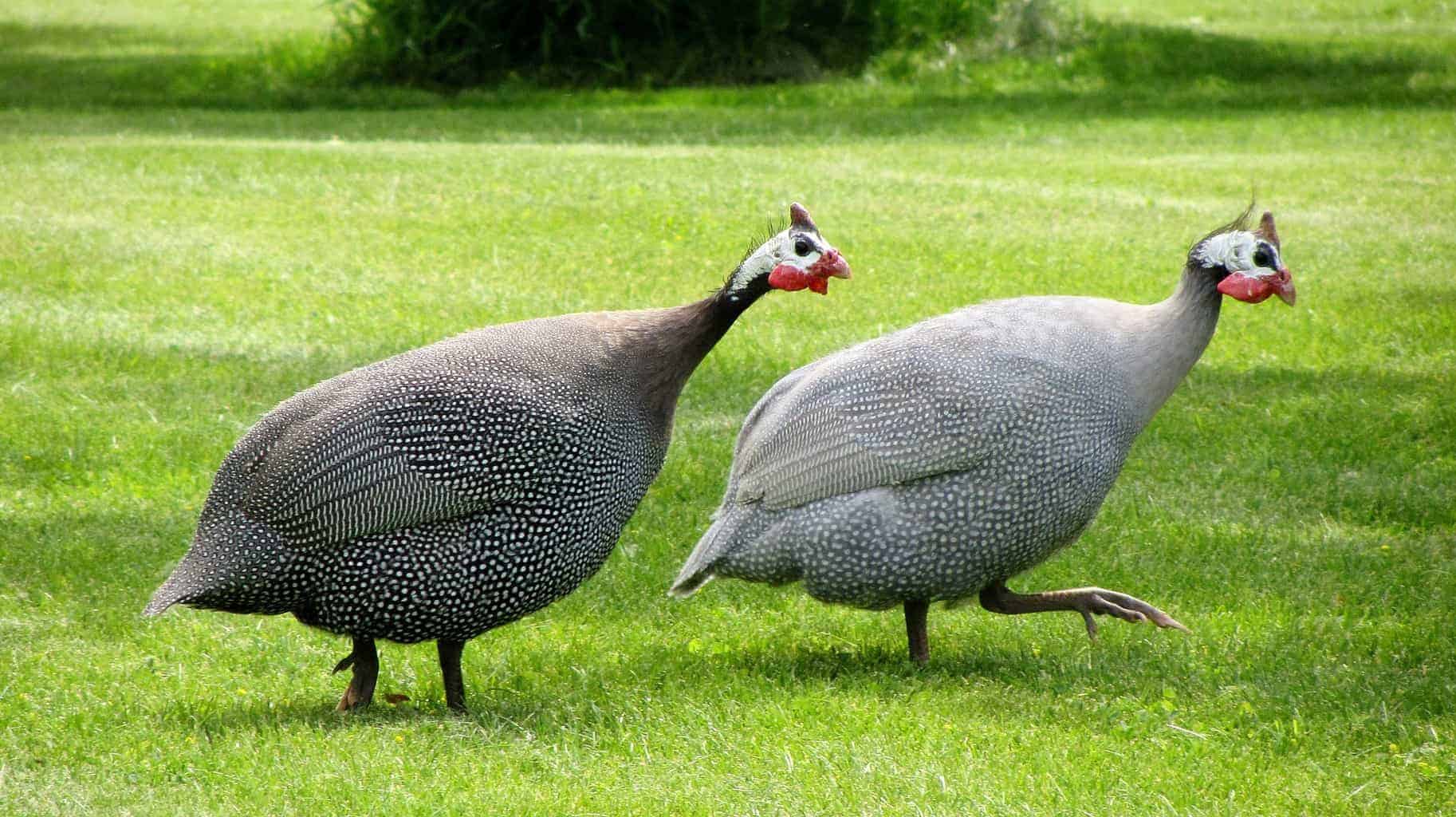
Guinea hens like nesting on the ground, so even if you’re keeping them with chickens, they won’t use nesting boxes. Instead, they construct deep, tapering nests that can hold up to 30 eggs, and multiple guinea hens use the same nest. They keep these nests well-hidden to protect them from predators, so you may need some scavenger hunt skills to find top spots.
Avoid this by placing the guinea hen nest boxes at ground level. You can use the same type as your chickens but position them lower. Guinea hens usually lay their eggs before lunch so if you want them to lay indoors, don’t let them out of the coop until noon. That saves you hours of egg-hunting around the yard. It will also lessen the chances of predators stealing the eggs.
Remember that guineas jump higher and fly further than chickens, so you need to cover the coop with chicken mesh. You can run chicken wire or concrete under the coops as well since guineas are defenseless in the dark. During the day, their clucking keeps predators away, but at night, their eyesight is limited so their enemies can burrow beneath the coop to get them.
This is probably why guineas prefer to roost in trees and high places, selecting taller perches and branches than chickens would. That said, guineas can live in the same style of coops as chickens. Just be wary of the guinea cocks attacking the chicken roosters – they can get quite aggressive during the day. But these males rarely fight at night and can share sleeping spots.
Taming Your Guinea Fowls
Chickens don’t stray far from home. But just like cats, guineas have to be persuaded to stick around. When you first get them, keep them inside the coop for two or three weeks. If they roam any sooner, they’re unlikely to come back. They’re wary creatures. Ensure the coop has no obstacles or barriers. They need to see everything around them so they can acclimatize.
After a few weeks, let one bird out of the coop. It won’t want to be far from its friends, so it’ll stay within reach as it explores. At night, bring it back indoors to sleep. Wait a few days then let a second guinea out and watch them. They may try to run off together, so don’t leave them unsupervised. If they hang around, they’ve accepted their territory. The others can come out.
Once they can safely forage, your guineas will sort out their own food. They know what their bodies need so they’ll seek the right bugs, seeds, and even occasional greens. You can offer oyster shell grit as a supplement, but they’ll probably find gravel as well. It’s fine to scatter cereals to scratch and nibble. They rarely eat corn, but they like sorghum, wheat, and millet.
Still, if you don’t want them finding their own food, unmedicated chicken feed works fine. They don’t need vaccines or chemicals because their wild stock protects them from common poultry diseases. But since their bodies are leaner, they need higher protein volumes than chickens. If you’re restricting them to chicken feed, provide protein-rich grass like alfalfa.
Housing Tips for Guineas
You can buy guinea eggs online or from trusted breeders. Because guinea fowls originate in Africa, their keets don’t like the cold. Use a porcelain heat lamp set at 95°F (35°C) for two or three weeks. After that, drop the heat by about five degrees per week until it reaches ambient room temperature. They won’t need lamps once their feathers grow fully at about 8 weeks.
Until then, infrared lighting is safer because the birds may mistake any exposed power chords for food (worms and snakes). Ensure the coops are well-ventilated with minimal moisture and low humidity. Use straw or sawdust as a substrate to absorb stool and use nipples for water since open water troughs can raise the moisture levels inside the coop.
Since guineas are naturally wilder than chickens, you should hold and handle them as soon as they hatch. Continue to touch and interact with them as they grow so they can get used to your presence and will be less likely to run away. You can also clip their wings so they can’t fly high enough to escape. Some consider this cruel, so if it bothers you, use a covered coop.
A guinea fowl can live to 12 years but the hens are only productive for the first four or five years. You can still keep them after they stop laying since they’ll still alert you when your coop gets unwanted attention. And unless they’re a dual-purpose breed with a good amount of meat, guinea layers aren’t worth slaughtering. Keep them as pets and senior guard hens.


